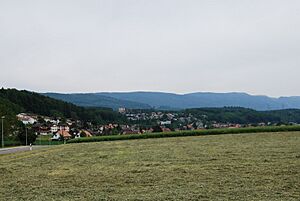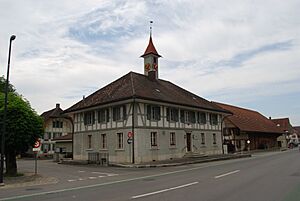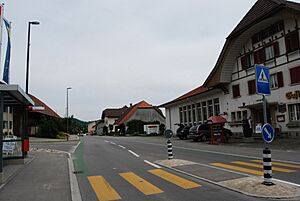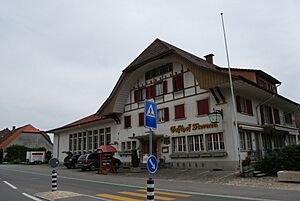Safnern facts for kids
Quick facts for kids
Safnern
|
||
|---|---|---|
 |
||
|
||
| Country | Switzerland | |
| Canton | Bern | |
| District | Biel/Bienne | |
| Area | ||
| • Total | 5.62 km2 (2.17 sq mi) | |
| Elevation | 436 m (1,430 ft) | |
| Population
(Dec 2020 )
|
||
| • Total | 1,951 | |
| • Density | 347.2/km2 (899.1/sq mi) | |
| Postal code |
2553
|
|
| Surrounded by | Pieterlen, Meinisberg, Büren an der Aare, Meienried, Scheuren BE, Orpund, Biel/Bienne | |
Safnern is a small town, also called a municipality, in the Bern area of Switzerland. It is part of the Biel/Bienne administrative district.
Contents
History of Safnern
Safnern was first written about in the year 1251. Back then, it was known as Savenieres.
Ancient Times and Middle Ages
The oldest signs of people living here are the remains of a Roman settlement. It was found in an area called Moosmühle. During the Middle Ages, there were many small villages and homes scattered around where Safnern is today.
Some villages, like Büttenberg and Stadholz, and a castle on Schlösslihubel hill, grew and then were later left empty. Important landowners in Safnern included the Counts of Neuchâtel-Nidau and Gottstatt Abbey.
Becoming Part of Bern
When the Neuchâtel-Nidau family line ended in 1375, Safnern came under the control of Bern. It became a court within the bailiwick (an old type of district) of Nidau. This lasted until the French invaded in 1798.
After the French invasion, Safnern became part of the Büren district. Later, in 1803, it moved to the Nidau district.
Changes by the Rivers
By 1783, Safnern was a large village with 50 houses. People living near the Zihl/Thielle and Aare rivers grew crops in the rich soil and fished.
A big project called the Jura water correction in 1847-48 changed the path of the Aare river. This helped protect the village from floods. The Nidau-Büren Canal, built from 1868 to 1875, also changed the land around Safnern. Even today, the town's border still follows the old riverbeds.
Modern Safnern
As Biel grew into a big industrial city in the 1950s, Safnern became a nearby suburb. Even though Safnern has some factories, most people (about three-quarters) travel to work in Biel or other towns.
In 2005, about 60% of jobs in Safnern were in industry, and 28% were in services. Safnern is also surrounded by nature. It shares the Häftli nature reserve with nearby towns like Büren an der Aare and Meinisberg.
Geography of Safnern
Safnern covers an area of about 5.6 square kilometers (2.2 square miles).
Land Use
As of 2012, about 43.6% of the land is used for farming. Forests cover 33.8% of the area. About 17.8% of the land has buildings or roads. Rivers and lakes make up 3.0%, and 2.0% is unproductive land.
Most of the forested land is covered with thick forests. For farming, 35.8% is used for crops, 6.4% for pastures, and 1.4% for orchards or vineyards. About 2.1% of the water in the town is in lakes, and 0.9% is in rivers and streams.
Location and Rivers
Safnern is located in the Bernese Seeland region. It sits at the bottom of the Bütten Mountains. The town is also along the Nidau-Büren channel and the old riverbeds of the Zihl and Aare rivers.
On December 31, 2009, Safnern's old district, Amtsbezirk Nidau, was closed. The next day, January 1, 2010, Safnern joined the new Verwaltungskreis Biel/Bienne district.
Safnern's Coat of Arms
The blazon (description) of Safnern's municipal coat of arms is quite detailed. It shows a red background with a golden zigzag pattern. Below that, it has a gold background with a wavy blue line and three green hills.
People of Safnern (Demographics)
Safnern has a population of about 1,873 people (as of December 2011). In 2010, about 5.2% of the people living here were foreign nationals.
Languages Spoken
Most people in Safnern speak German as their main language. In 2000, about 92.9% of the population spoke German. French was the second most common language (4.6%), followed by Italian (0.8%).
Population Makeup
In 2008, the population was made up of 48.5% males and 51.5% females. Most residents were Swiss citizens.
About 25.7% of the people living in Safnern in 2000 were also born there. Another 46.5% were born in the same canton (Bern).
Age Groups
As of 2011, children and teenagers (ages 0–19) make up 22.2% of the population. Adults (ages 20–64) make up 58.6%, and seniors (over 64 years old) make up 19.2%.
Population Over Time
The chart below shows how Safnern's population has changed over many years:

Economy of Safnern
In 2011, Safnern had a very low unemployment rate of 1%. This means almost everyone who wanted a job had one.
Jobs in Safnern
As of 2008, there were 524 people working in Safnern.
- Primary sector: 44 people worked in farming and related businesses.
- Secondary sector: 298 people worked in manufacturing and construction.
- Tertiary sector: 182 people worked in service jobs, like shops, restaurants, and healthcare.
Many people who live in Safnern travel to other towns for work. In 2000, 725 workers left Safnern for jobs elsewhere, while 365 came into Safnern to work. About 40% of the workers in Safnern also lived there.
How People Travel to Work
Of the working population, 13.1% used public transportation to get to work. Most people, 61.7%, used a private car.
Religion in Safnern
Based on the 2000 census, most people in Safnern belong to the Swiss Reformed Church (69.6%). The next largest group was Roman Catholic (13.4%).
A smaller number of people belonged to other Christian churches (3.71%). There were also some people who were Islamic (1.29%). About 8.77% of the population said they did not belong to any church or were agnostic or atheist.
Education in Safnern
In Safnern, about 62.7% of adults have finished upper secondary education. This is like high school. Also, 19.4% have gone on to higher education, like university or a specialized college.
School System
The school system in the Canton of Bern works like this:
- One year of non-required Kindergarten.
- Six years of Primary school.
- Three years of required lower Secondary school. Here, students are grouped by their abilities.
After lower Secondary, students can continue their studies or start an apprenticeship (learning a trade on the job).
Students in Safnern
During the 2011-12 school year, 154 students attended classes in Safnern.
- There were 2 kindergarten classes with 28 students.
- There were 6 primary classes with 126 students.
In 2000, 141 students lived and went to school in Safnern. Another 115 students from Safnern went to schools outside the town.
Notable People from Safnern
- Friedrich Gottlieb Stebler (1852–1935): He was a Swiss expert in farming and a person who studied cultures and customs.
See also
 In Spanish: Safnern para niños
In Spanish: Safnern para niños








